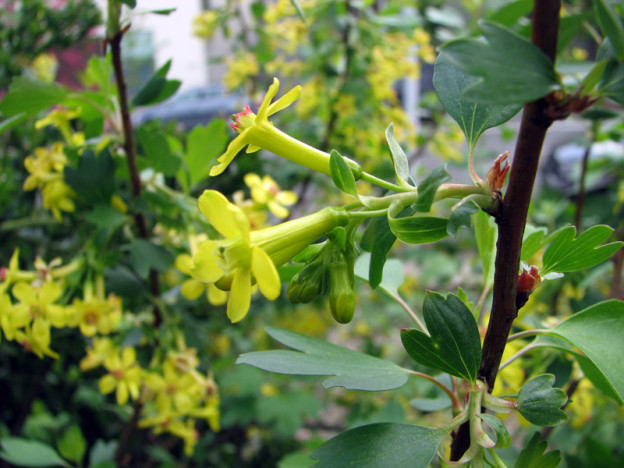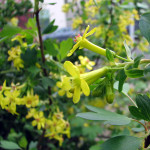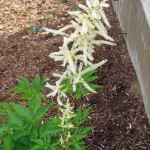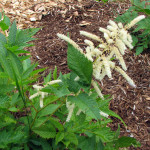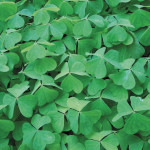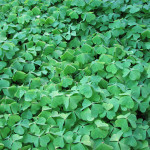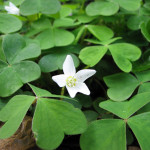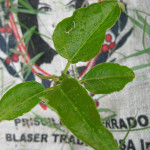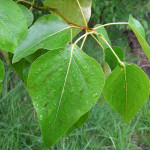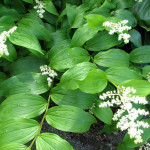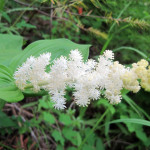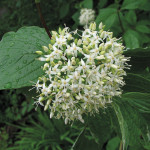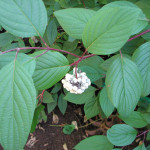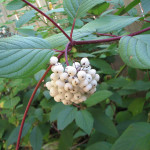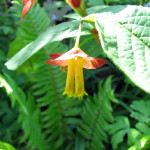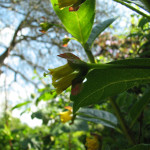Ribes aureum
Golden currant (Ribes aureum) is a small to medium-sized deciduous shrub named for its golden flowers and golden red fall foliage. It is common in Oregon and Washington east of the Cascades and into the Great Basin.
Golden currant grows in full sun and partial shade, in dry to moist conditions, and is drought tolerant. The leaves are deciduous, lobed, and vaguely maple-like, ½ – 1½ inches. Charming clusters of yellow flowers bloom from mid- to late-spring. Golden currant grows to approximately 6 feet tall by 6 feet wide.
It attracts hummingbirds and butterflies such as the spring azure and mourning cloak, and the fruit is eaten by birds and other wildlife. Combine this in a sunny spot with its cousin, red-flowering currant, and drought-tolerant groundcovers like alliums and camas, for a beautiful native display!
- Light Requirements: Full Sun, Part Shade
- Water Requirements: Dry, Moist
- Ease of Growing:
- Growth Rate: Moderate
- Spreads: No
- Wildlife Support: Hummingbirds, Birds or Mammals
- Fire-resistant: No
- Edible: Yes
- Mature Height: 6ft
- Mature Width:6ft
Goat’s Beard

Aruncus dioicus
Goat’s Beard has decorative finely-cut foliage and will create a bold, showy effect for a moist or partly-shaded spot all season. Dense, feathery plumes of tight white flowers rise well above the foliage spring to summer.
Goat’s Beard is an excellent background plant or grouped in a woodland setting. It dies back to the ground in winter, only to return gloriously in the spring. Goat’s Beard spreads slowly by rhizomes to form attractive patches, and can be planted in more sunny areas provided there is good moisture. It’s a “host” plant to the Dusky Azure Butterfly.
- Light Requirements: Part Shade, Full Shade
- Water Requirements: Moist, Perennially Wet
- Ease of Growing: Easy to grow
- Growth Rate: Fast
- Spreads: Yes
- Wildlife Support: Pest-eating Insects, Birds or Mammals, Pollinators
- Fire-resistant: No
- Edible: No
- Mature Height: 5-15ft
- Mature Width:3-5ft
Western Hemlock

Tsuga heterophylla
Western hemlock (Tsuga heterophylla) is the state tree of Washington, and the largest species of hemlock, growing up to 200′ tall with a trunk diameter of up to 4′. It makes a beautiful addition to any property where it has room to grow.
Western hemlocks grow into a narrow, upright, somewhat ragged cone as they grow, with very top of the tree typically drooping over just a little bit. The needles are short and flat, averaging less than 1″ long. The small round cones dangle from the branches and have long, thin, flexible scales. The bark is thin, brown, and furrowed in texture.
This tree is an important source of food for many birds and mammals. Yellow-bellied sapsuckers nest in the tree’s cavities, and barred owls prefer dense stands of Western hemlock. Flying squirrels and other small mammals nest in hemlocks, and many animals browse the inner bark and young needles and take shelter in the dense foliage.
Western hemlock is a very shade-tolerant tree, with young plants able to grow under a closed canopy of fast-growing, shade-intolerant conifers such as Douglas-fir. Disturbances like fire or logging open up sunny areas where new generations of Douglas-fir and other sun-loving seedlings can survive, but without that disturbance, hemlocks end up dominating the canopy…and Western hemlocks can live up to 1200 years old! If you are in a forest made up of mostly large hemlocks, you know that forest has been undisturbed for a very long time.
- Light Requirements: Full Sun, Part Shade, Full Shade
- Water Requirements: Dry, Moist
- Ease of Growing: Easy to grow
- Growth Rate: Fast
- Spreads: No
- Wildlife Support: Pest-eating Insects, Birds or Mammals
- Fire-resistant: No
- Edible: No
- Mature Height: 120-200
- Mature Width:30-40ft
Oregon Oxalis
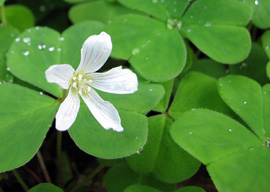
Oxalis oregana
Oxalis oregana, also known as Redwood sorrel, is a species of the wood sorrel family, Oxalidaceae, native to moist Douglas-fir and Coast Redwood forests of western North America from southwestern British Columbia, Washington, Oregon, and California. This attractive groundcover can spread vigorously when planted in favorable conditions.
It is a short herbaceous perennial plant with erect flowering stems 5-15 cm tall. The three leaflets are heart-shaped, 1-4.5 cm long on 5-20 cm stalks. The inflorescence is 2.4-4 cm in diameter, white to pink with five petals and sepals. The hairy five-chambered seed capsules are egg-shaped, 7-9 mm long; seeds are almond shaped.
Oregon oxalis photosynthesizes at relatively low levels of ambient light (1/200th of full sunlight). When direct sunlight strikes the leaves they fold downwards; when shade returns, the leaves reopen. This process only takes a few minutes and the movement is observable to the eye.
The tangy leaves of Oregon oxalis were eaten by Native Americans, probably in small quantities, since they contain mildly toxic oxalic acid (hence the genus name).
- Light Requirements: Part Shade, Full Shade
- Water Requirements: Moist
- Ease of Growing: Easy to grow
- Growth Rate: Moderate
- Spreads: Yes
- Wildlife Support: Birds or Mammals
- Fire-resistant: Yes
- Edible: Yes
- Mature Height: 6-8in
- Mature Width:2-3ft
Black Cottonwood

Populus trichocarpa
Balsam poplar (Populus balsamifera) is the northernmost American hardwood, and grows across the continent. Though it appears in upland areas, it thrives in floodplains. It is our tallest native broad-leaved tree, and has dark grey bark. In the spring and early summer the sticky resin on leaf buds releases a strong, balsamic fragrance. It is hardy, fast-growing, and relatively short-lived, though some trees have been known to live for 200 years. Other names are balm-of-gilead, bam, tacamahac, cottonwood, or heartleaf balsam poplar.
Wildlife
The leaves of the balsam poplar serve as food for various caterpillars in the order Lepidoptera. It is an important browse for deer and elk and provides nesting habitat for large birds. The anti-infectant property of the resin is used by bees, who seal intruders in it to prevent decay and protect the hive.
Uses
A great riparian restoration species. The light, soft wood is used for paper pulp and construction lumber.
- Light Requirements: Full Sun, Part Shade
- Water Requirements: Dry, Moist, Seasonally Wet, Perennially Wet
- Ease of Growing: Easy to grow
- Growth Rate: Fast
- Spreads: No
- Wildlife Support: Birds or Mammals
- Fire-resistant: No
- Edible: No
- Mature Height: 175ft
- Mature Width:40ft
False Solomon’s Seal
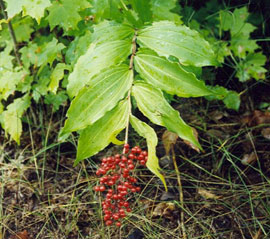
Maianthemum racemosum
False Solomon’s seal is a clump-forming perennial which typically grows 2-3′ tall and slowly spreads by thick rhizomes, often forming large colonies in the wild. Features unbranched, gracefully arching stems of alternate, oval, pointed, light green leaves with conspicuously parallel veins. Tiny, fragrant, creamy white flowers appear at the stem ends in terminal, plumy, spirea-like racemes (hence the species name) in spring.
Flowers are followed by greenish berries which turn an attractive ruby red in summer, often persisting into fall unless earlier consumed by wildlife. Foliage turns yellow in fall. Foliage resembles that of the true Solomon’s seals (Polygonatum spp.), but the latter have distinctly different flowers (i.e., bell-shaped flowers which droop from the leaf axils all along the stems).
- Light Requirements: Part Shade, Full Shade
- Water Requirements: Moist
- Ease of Growing: Easy to grow
- Growth Rate: Moderate
- Spreads:
- Wildlife Support: Pest-eating Insects, Birds or Mammals
- Fire-resistant: Yes
- Edible:
- Mature Height: 1-3ft
- Mature Width:1-2ft
Red-osier Dogwood

Cornus sericea
Red osier dogwood (Cornus sericea) is a medium to tall deciduous shrub. It can grow 6-15 feet tall and 5-10 feet wide depending on site conditions, and spreads to form dense thickets. It is attractive year round with red winter twigs (especially in sunny sites), creamy-white flower clusters, red to purple fall color, and bluish-green to white fruits.
This shrub is excellent for wildlife. Painted lady butterflies visit the flowers for nectar, and spring azure butterflies lay their eggs on the newly developing leaves and buds. Dozens of species of birds and mammals rely on it for food year-round, eating the new shoots in the spring, berries in summer and fall, and twigs through the winter. Birds take cover and nest in the shrubs, and even some amphibians lay more eggs in wetlands with red osier dogwoods than without.
Cuttings readily root, and it is an excellent shrub for improving the health of stream banks and wetlands. In the wild, it commonly grows in wetlands and other habitats with damp soil.
- Light Requirements: Full Sun, Part Shade
- Water Requirements: Moist, Seasonally Wet, Perennially Wet
- Ease of Growing: Easy to grow
- Growth Rate: Fast
- Spreads: Yes
- Wildlife Support: Pollinators, Hummingbirds, Birds or Mammals
- Fire-resistant: Yes
- Edible: No
- Mature Height: 15ft
- Mature Width:6-9ft
Black Twinberry
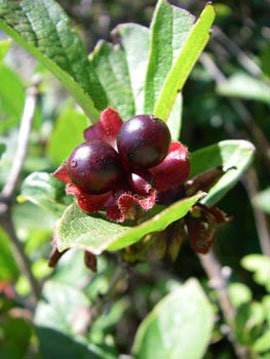
Lonicera involucrata
Black twinberry (Lonicera involucrata) is also known as “twinberry honeysuckle”. Named for its pairs of flowers and fruits, this attractive shrub grows up to 10 feet tall. Tube-shaped yellow to orange flowers bloom April – July, followed by dark purple berries surrounded by showy red bracts. Young branches have yellow bark which age to yellow-brown.
The flowers provide nectar for hummingbirds and bumblebees, and the berries are eaten by numerous birds. Twinberry is also a food plant for the young of Gillette’s Checkerspot butterfly. This wetland plant grows best in sun or partial shade and moist soil.
- Light Requirements: Full Sun, Part Shade
- Water Requirements: Moist, Seasonally Wet
- Ease of Growing: Easy to grow
- Growth Rate: Moderate
- Spreads: No
- Wildlife Support: Pollinators, Hummingbirds, Birds or Mammals
- Fire-resistant: Yes
- Edible: No
- Mature Height: 8-10ft
- Mature Width:4-10ft

